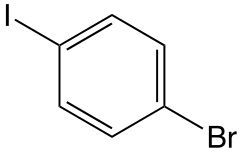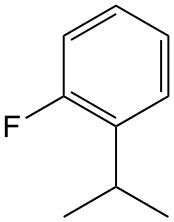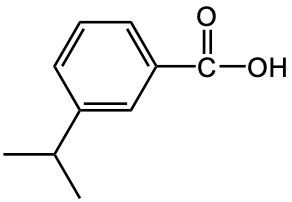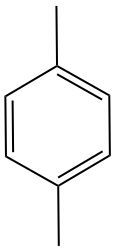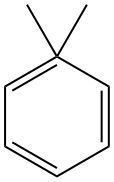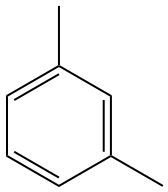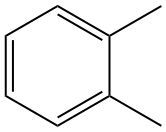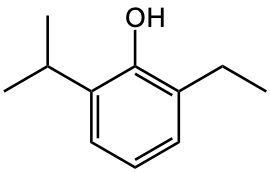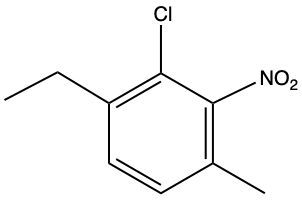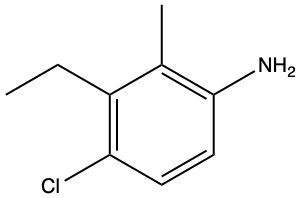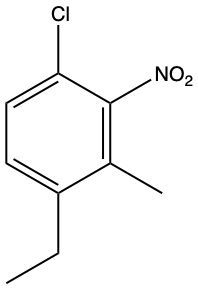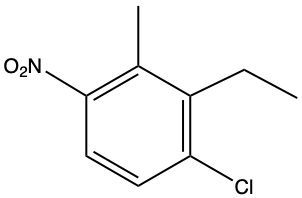In this video, we're going to take a look at naming monosubstituted benzenes. Here we're going to say a monosubstituted benzene is a compound where benzene is the parent chain with only 1 substituent. Now here this represents the simplest benzene to name, and because there's only 1 substituent, the location of that substituent is not necessary. So in terms of our naming convention, we have our substituent name followed by the end of the name as benzene.
- 1. Matter and Measurements4h 29m
- What is Chemistry?5m
- The Scientific Method9m
- Classification of Matter16m
- States of Matter8m
- Physical & Chemical Changes19m
- Chemical Properties8m
- Physical Properties5m
- Intensive vs. Extensive Properties13m
- Temperature (Simplified)9m
- Scientific Notation13m
- SI Units (Simplified)5m
- Metric Prefixes24m
- Significant Figures (Simplified)11m
- Significant Figures: Precision in Measurements7m
- Significant Figures: In Calculations19m
- Conversion Factors (Simplified)15m
- Dimensional Analysis22m
- Density12m
- Specific Gravity9m
- Density of Geometric Objects19m
- Density of Non-Geometric Objects9m
- 2. Atoms and the Periodic Table5h 23m
- The Atom (Simplified)9m
- Subatomic Particles (Simplified)12m
- Isotopes17m
- Ions (Simplified)22m
- Atomic Mass (Simplified)17m
- Atomic Mass (Conceptual)12m
- Periodic Table: Element Symbols6m
- Periodic Table: Classifications11m
- Periodic Table: Group Names8m
- Periodic Table: Representative Elements & Transition Metals7m
- Periodic Table: Elemental Forms (Simplified)6m
- Periodic Table: Phases (Simplified)8m
- Law of Definite Proportions9m
- Atomic Theory9m
- Rutherford Gold Foil Experiment9m
- Wavelength and Frequency (Simplified)5m
- Electromagnetic Spectrum (Simplified)11m
- Bohr Model (Simplified)9m
- Emission Spectrum (Simplified)3m
- Electronic Structure4m
- Electronic Structure: Shells5m
- Electronic Structure: Subshells4m
- Electronic Structure: Orbitals11m
- Electronic Structure: Electron Spin3m
- Electronic Structure: Number of Electrons4m
- The Electron Configuration (Simplified)22m
- Electron Arrangements5m
- The Electron Configuration: Condensed4m
- The Electron Configuration: Exceptions (Simplified)12m
- Ions and the Octet Rule9m
- Ions and the Octet Rule (Simplified)8m
- Valence Electrons of Elements (Simplified)5m
- Lewis Dot Symbols (Simplified)7m
- Periodic Trend: Metallic Character4m
- Periodic Trend: Atomic Radius (Simplified)7m
- 3. Ionic Compounds2h 18m
- Periodic Table: Main Group Element Charges12m
- Periodic Table: Transition Metal Charges6m
- Periodic Trend: Ionic Radius (Simplified)5m
- Periodic Trend: Ranking Ionic Radii8m
- Periodic Trend: Ionization Energy (Simplified)9m
- Periodic Trend: Electron Affinity (Simplified)8m
- Ionic Bonding6m
- Naming Monoatomic Cations6m
- Naming Monoatomic Anions5m
- Polyatomic Ions25m
- Naming Ionic Compounds11m
- Writing Formula Units of Ionic Compounds7m
- Naming Ionic Hydrates6m
- Naming Acids18m
- 4. Molecular Compounds2h 18m
- Covalent Bonds6m
- Naming Binary Molecular Compounds6m
- Molecular Models4m
- Bonding Preferences6m
- Lewis Dot Structures: Neutral Compounds (Simplified)8m
- Multiple Bonds4m
- Multiple Bonds (Simplified)6m
- Lewis Dot Structures: Multiple Bonds10m
- Lewis Dot Structures: Ions (Simplified)8m
- Lewis Dot Structures: Exceptions (Simplified)12m
- Resonance Structures (Simplified)5m
- Valence Shell Electron Pair Repulsion Theory (Simplified)4m
- Electron Geometry (Simplified)8m
- Molecular Geometry (Simplified)11m
- Bond Angles (Simplified)11m
- Dipole Moment (Simplified)15m
- Molecular Polarity (Simplified)7m
- 5. Classification & Balancing of Chemical Reactions3h 17m
- Chemical Reaction: Chemical Change5m
- Law of Conservation of Mass5m
- Balancing Chemical Equations (Simplified)13m
- Solubility Rules16m
- Molecular Equations18m
- Types of Chemical Reactions12m
- Complete Ionic Equations18m
- Calculate Oxidation Numbers15m
- Redox Reactions17m
- Spontaneous Redox Reactions8m
- Balancing Redox Reactions: Acidic Solutions17m
- Balancing Redox Reactions: Basic Solutions17m
- Balancing Redox Reactions (Simplified)13m
- Galvanic Cell (Simplified)16m
- 6. Chemical Reactions & Quantities2h 35m
- 7. Energy, Rate and Equilibrium3h 46m
- Nature of Energy6m
- First Law of Thermodynamics7m
- Endothermic & Exothermic Reactions7m
- Bond Energy14m
- Thermochemical Equations12m
- Heat Capacity19m
- Thermal Equilibrium (Simplified)8m
- Hess's Law23m
- Rate of Reaction11m
- Energy Diagrams12m
- Chemical Equilibrium7m
- The Equilibrium Constant14m
- Le Chatelier's Principle23m
- Solubility Product Constant (Ksp)17m
- Spontaneous Reaction10m
- Entropy (Simplified)9m
- Gibbs Free Energy (Simplified)18m
- 8. Gases, Liquids and Solids3h 25m
- Pressure Units6m
- Kinetic Molecular Theory14m
- The Ideal Gas Law18m
- The Ideal Gas Law Derivations13m
- The Ideal Gas Law Applications6m
- Chemistry Gas Laws16m
- Chemistry Gas Laws: Combined Gas Law12m
- Standard Temperature and Pressure14m
- Dalton's Law: Partial Pressure (Simplified)13m
- Gas Stoichiometry18m
- Intermolecular Forces (Simplified)19m
- Intermolecular Forces and Physical Properties11m
- Atomic, Ionic and Molecular Solids10m
- Heating and Cooling Curves30m
- 9. Solutions4h 10m
- Solutions6m
- Solubility and Intermolecular Forces18m
- Solutions: Mass Percent6m
- Percent Concentrations10m
- Molarity18m
- Osmolarity15m
- Parts per Million (ppm)13m
- Solubility: Temperature Effect8m
- Intro to Henry's Law4m
- Henry's Law Calculations12m
- Dilutions12m
- Solution Stoichiometry14m
- Electrolytes (Simplified)13m
- Equivalents11m
- Molality15m
- The Colligative Properties15m
- Boiling Point Elevation16m
- Freezing Point Depression9m
- Osmosis16m
- Osmotic Pressure9m
- 10. Acids and Bases3h 29m
- Acid-Base Introduction11m
- Arrhenius Acid and Base6m
- Bronsted Lowry Acid and Base18m
- Acid and Base Strength17m
- Ka and Kb12m
- The pH Scale19m
- Auto-Ionization9m
- pH of Strong Acids and Bases9m
- Acid-Base Equivalents14m
- Acid-Base Reactions7m
- Gas Evolution Equations (Simplified)6m
- Ionic Salts (Simplified)23m
- Buffers25m
- Henderson-Hasselbalch Equation16m
- Strong Acid Strong Base Titrations (Simplified)10m
- 11. Nuclear Chemistry56m
- BONUS: Lab Techniques and Procedures1h 38m
- BONUS: Mathematical Operations and Functions47m
- 12. Introduction to Organic Chemistry1h 34m
- 13. Alkenes, Alkynes, and Aromatic Compounds2h 12m
- 14. Compounds with Oxygen or Sulfur1h 6m
- 15. Aldehydes and Ketones1h 1m
- 16. Carboxylic Acids and Their Derivatives1h 11m
- 17. Amines38m
- 18. Amino Acids and Proteins1h 51m
- 19. Enzymes1h 37m
- 20. Carbohydrates1h 46m
- Intro to Carbohydrates4m
- Classification of Carbohydrates4m
- Fischer Projections4m
- Enantiomers vs Diastereomers8m
- D vs L Enantiomers8m
- Cyclic Hemiacetals8m
- Intro to Haworth Projections4m
- Cyclic Structures of Monosaccharides11m
- Mutarotation4m
- Reduction of Monosaccharides10m
- Oxidation of Monosaccharides7m
- Glycosidic Linkage14m
- Disaccharides7m
- Polysaccharides7m
- 21. The Generation of Biochemical Energy2h 8m
- 22. Carbohydrate Metabolism2h 22m
- 23. Lipids2h 26m
- Intro to Lipids6m
- Fatty Acids25m
- Physical Properties of Fatty Acids6m
- Waxes4m
- Triacylglycerols12m
- Triacylglycerol Reactions: Hydrogenation8m
- Triacylglycerol Reactions: Hydrolysis13m
- Triacylglycerol Reactions: Oxidation7m
- Glycerophospholipids15m
- Sphingomyelins13m
- Steroids15m
- Cell Membranes7m
- Membrane Transport10m
- 24. Lipid Metabolism1h 45m
- 25. Protein and Amino Acid Metabolism1h 37m
- 26. Nucleic Acids and Protein Synthesis2h 54m
- Intro to Nucleic Acids4m
- Nitrogenous Bases16m
- Nucleoside and Nucleotide Formation9m
- Naming Nucleosides and Nucleotides13m
- Phosphodiester Bond Formation7m
- Primary Structure of Nucleic Acids11m
- Base Pairing10m
- DNA Double Helix6m
- Intro to DNA Replication20m
- Steps of DNA Replication11m
- Types of RNA10m
- Overview of Protein Synthesis4m
- Transcription: mRNA Synthesis9m
- Processing of pre-mRNA5m
- The Genetic Code6m
- Introduction to Translation7m
- Translation: Protein Synthesis18m
Naming Benzene - Online Tutor, Practice Problems & Exam Prep
 Created using AI
Created using AIMonosubstituted benzenes are named by placing the substituent name before "benzene." For disubstituted benzenes, substituents are numbered alphabetically, with positions indicated numerically or using ortho, meta, and para designations. Common names exist for certain monosubstituted benzenes, such as phenol and toluene. In polysubstituted benzenes, the common name's substituent is numbered as 1, and other substituents are numbered to minimize the total number. This systematic approach aids in understanding aromatic compounds and their reactivity in organic chemistry.
Monosubstituted Benzene Concept 1
Video transcript
Monosubstituted Benzene Example 1
Video transcript
For this example question, it says, give a systematic name of the following compound. So here we have benzene, and connected to it is this alkyl group. Now, this alkyl group has 4 carbons involved, which means that it could represent butyl, isobutyl, sec butyl, or tert butyl. Here we'd say, based on the way it looks, we have our connection on this carbon here, which is connected to 3 methyl groups. This represents a tert butyl. So the name of the alkyl group would be tert butyl, remember there's a hyphen there, and it's connected to a benzene. So, we end the name with benzene. So, this would be the name of our given compound, tert-butylbenzene.
Disubstituted Benzene Concept 2
Video transcript
Everyone, in this video, we're going to take a look at disubstitutive benzenes, which are compounds where benzene is the parent chain, and it has two substituents. Now these substituents are numbered in alphabetical order. So if we have, for example, Fluorine and Bromine, bromo comes before fluoro, so we'd start numbering at the bromo position. Now here, this would tell us in terms of the naming convention, we'd say the location of each substituent, and at the end of the name, we'd say Benzene.
Benzene itself is pretty unique because we could number where these two substituents are numerically as 1,2, 1,3, or 1,4, or we could do a brand-new way of designating their locations in the form of ortho, meta, and para. Here in this example, these are all dichlorobenzenes. The chlorines are in different locations. Now here, they're in positions 1,2 in this first image. Here when they're in the positions 1,2, we say 1,2-dichloro or we could say ortho-dichloro. In the next one, they are 1,3 to each other, so instead of saying 1,3-dichloro, we could say meta-dichloro. And then finally, there are positions 1,4 here, so we have 1,4-dichlorobenzene, or we could say para-dichlorobenzene.
Now, the two substituents don't have to be the same, they could be the same or they can be different from each other. This ortho, meta, and para convention still would work. Now our memory tool here to help us remember the order is "order more pizza." Now I know in college, a lot of us kinda survive on pizza, at least that's the way it was for me when I was in college. So "order more pizza" gives us the letter designation of 1,2, 1,3, and 1,4. Order 1,2, ortho, more, 1,3, meta, and pizza, 1,4, para. Alright? So keep that in mind. We can name these two substituents by our traditional numerical method, or we could do ortho, meta, and para.
Disubstituted Benzene Example 2
Video transcript
In this example question, it asks to give a systematic name for the following compound. In this compound, we have a benzene ring connected to two alkyl groups, which happen to be ethyl groups. They are both two-carbon chains. Here, you could start numbering at either carbon position on the benzene because they are identical. So, this could be 1, 2, 3, or you could go the other way, 1, 2, 3, 5, and 6. We have two ethyl groups in positions 1 and 3, so their numerical location is 1-3. There are two of them that are chemically indentical, so it's 'di,' and they are ethyl, and we end the name with benzene. Thus, the systematic name would be 1,3-Diethylbenzene.
Now, if they wanted us to provide the common name using ortho, meta, or para, since the groups are located at 1 and 3, the more common naming would be meta-diethylbenzene. Although the question does not ask for this, I'm mentioning it so that you can see the differences between the two naming systems. However, our official answer is 1,3-Diethylbenzene.
Determine the systematic name of the molecule.
1-iodo-4-bromobenzene
1-bromo-4-iodobenzene
4-bromo-1-iodobenzene
4-iodo-1-bromobenzene
Determine the systematic name of the molecule.
ortho-fluoroisopropylbenzene
para-fluoroisopropylbenzene
meta-fluoroisopropylbenzene
1-fluoro-2-tert-butylbenzene
Common Naming of Disubstituted Benzene Concept 3
Video transcript
Many mono-substituted benzenes have common names in addition to their systematic names. If we take a look here, we have some common names for mono-substituted benzenes. When there's a OH group attached to benzene, it's called phenol. When it's an NH2 group, an amine group, it's aniline. A CH3, it becomes toluene. Here OCH3 becomes anisole; when we have an aldehyde connected, it becomes benzaldehyde, and when we have a carboxylic acid group, it becomes benzoic acid. Now here, we're going to say if a disubstituted benzene, meaning it has two groups, disubstituted benzene, has one of these substituents, the common name becomes the parent name. Now we're going to say ortho, meta, and para prefixes denote the relative positions of the two substituents. So if we take a look, we have here benzene with one of those groups, a methyl group. We know that the common name for that would be toluene, but it's not just a methyl group attached, there's also a chlorine attached. It's in position 2 if we make this position 1; this would be position 2. Remember the one-two relationship is ortho, so that's why it's ortho here. And then it'll be chloro for the chlorine, and again a methyl group connected to benzene is toluene. So the name here would be ortho-chlorotoluene.
Common Naming of Disubstituted Benzene Example 3
Video transcript
Here it says write a common name for the following molecule. So here we have a benzene ring with emphasis on the OH group. And in addition to this, we have a bromine. Now step 1 is to identify the part of the structure with a common name. We're highlighting the OH group. Remember, when the OH group is connected to benzene, its common name is phenol. Step 2, assign a name to the other substituent. It's a bromine, so that would be bromo. Determine the prefix to denote the relative positions of the 2 substituents. So where the OH is connected is carbon number 1, and this is 2, 3, 4. The 2 substituents are in positions 1,4, which is para. And then write the name of the compound without spaces, so it'd be para-bromophenol. Or you could write it as p-bromophenol. P standing in for para. Alright. So this will be the name, the common name of this disubstituted benzene.
Write a common name for the following compound.
o-tertbutylbenzoic acid
p-isopropylbenzoic acid
5-tertbytylbenzoic acid
m-isopropylbenzoic acid
The common name for a disbstituted benzene with two methyl groups is xylene. Draw a structure for meta-xylene.
Naming Polysubstituted Benzene Concept 4
Video transcript
When it comes to naming polysubstituted benzenes, we say that the locations of substituents must be denoted by numbers. Here, we say that the carbon atom with the substituent that makes the common name is always numbered 1. So, if we take a look here, the substituent of interest is the OH group. Its common name is phenol. But in addition to this, we have a bromine group and a chlorine group. Where the OH group is located is carbon number 1, and then we need to number in a way to reach the other two substituents as quickly as possible. So, we have to go clockwise towards bromine, and then towards chlorine. Now, naming it alphabetically, we're going to say bromo (B) comes before chloro (C). So, it’d be 2-bromo, 4-chloro, and then the common name, phenol.
Now, if we take a look here, we have toluene as the common name, which is a benzene connected to a CH3 group, and it says "trinitro". Nitro is a common type of substituent on benzene structures. Nitro is designated by NO2. So the NO2 group is the nitro group. We're going to say where the CH3 group is located at carbon 1, and then we're going to go clockwise, or you could go counterclockwise because either way, this could be 2 or this could be 2. Both substituents, you get to them as fast as possible. So 2, 3, 4, 5, 6. So there's an NO2 group on 2, an NO2 group on 3, and then an NO2 group on 4, and then an NO2 group on 6. Notice how I write 6, because again the bond is what's connecting carbon to nitrogen. So, I have to write it as N first, and then the two oxygens later. Alright. So here, we'd say that the nitro groups are on carbons 2, 4, and 6. There are three of them, that's why it's tri. They are nitro groups. And then, methyl with a benzene attached is toluene. So the full name here would be 2,4,6-trinitrotoluene.
Now, one more interesting thing about this is if we look at some of the letters: T, N, T. So TNT, dynamite. This is the structural makeup of dynamite. Right? So, 2,4,6-trinitrotoluene, you've learned the official name for it. Again, when we're dealing with polysubstituted benzenes, we're going to use numbers to talk about the locations of all these substituents.
Naming Polysubstituted Benzene Example 4
Video transcript
Write a name for the following compound. So here we have benzene connected to 2 halogens in the form of fluorine and chlorine, an NH2 group, and an NO2 group. Remember, NO2 itself represents a nitro group. Right. So step 1 is we identify the substituent that gives the structure a common name. Here the structure in question is NH2. We're going to say here, the carbon atom with that substituent is location 1, so this would be 1. Assign names to all the other substituents. So here this would be chloro, this would be nitro, and this would be fluoro. Continuing numbering the ring in the direction of the closest substituent. Right now we could say carbon number 2 could be the one with the chlorine, or carbon number 2 could be the one with the nitro group. If a tie between substituents, compare the next closest substituent. So here we go, 1, 2, 3, 4 or 1, 2, 3, 4. In both cases, the next closest substituent is fluorine, which is on carbon number 4. Alright. So they're still tied. If still a tie, number the ring in alphabetical order. So here, in alphabetical order, Chloro (C) comes before Nitro (N). So this would be the way we count. So 1, 2, 3, 4, 5, 6. Repeat steps from previous naming topics. Write the name of the compound without spaces. Alright. So we're going to say that a benzene with an NH2 group is called aniline. That's the common name. And then we would write the substituents alphabetically. C is first, so 2-chloro. Next is fluorine, 4-fluoro. And then we have a nitro group on 6, 6-nitroaniline. No space between nitro and aniline. So this would be the common name for this following polysubstituted benzene.
Write an IUPAC name for the following compound.
2-ethyl-6-isopropylphenol
2-isopropyl-6-ethylphenol
2-isopropyl-6-ethylanisole
2-ethyl-6-isopropylanisole
Draw a structure for 3-chloro-2-ethyl-6-nitrotoluene.
Do you want more practice?
Here’s what students ask on this topic:
What is the naming convention for monosubstituted benzenes?
Monosubstituted benzenes are named by placing the name of the substituent before the word 'benzene.' For example, if a methyl group (CH3) is attached to the benzene ring, the compound is named methylbenzene. Some monosubstituted benzenes also have common names. For instance, a benzene ring with an OH group is called phenol, and with a CH3 group, it is called toluene. The position of the substituent is not specified because there is only one substituent, making its location implicit.
 Created using AI
Created using AIHow are disubstituted benzenes named using the ortho, meta, and para designations?
Disubstituted benzenes can be named using the ortho (o-), meta (m-), and para (p-) designations to indicate the relative positions of the substituents. 'Ortho' (o-) indicates that the substituents are on adjacent carbons (1,2-positions), 'meta' (m-) indicates that they are separated by one carbon (1,3-positions), and 'para' (p-) indicates that they are opposite each other on the benzene ring (1,4-positions). For example, if two chlorine atoms are attached to the benzene ring at the 1 and 2 positions, the compound is named ortho-dichlorobenzene or 1,2-dichlorobenzene.
 Created using AI
Created using AIWhat are some common names for monosubstituted benzenes?
Several monosubstituted benzenes have common names in addition to their systematic names. For example, a benzene ring with an OH group is called phenol, with an NH2 group is called aniline, with a CH3 group is called toluene, with an OCH3 group is called anisole, with an aldehyde group is called benzaldehyde, and with a carboxylic acid group is called benzoic acid. These common names are often used in place of the systematic names due to their simplicity and historical usage.
 Created using AI
Created using AIHow are polysubstituted benzenes named?
Polysubstituted benzenes are named by numbering the carbon atoms in the benzene ring to give the substituents the lowest possible numbers. The substituent that gives the common name to the compound is always assigned position 1. The other substituents are then numbered to minimize the total number. For example, in 2,4,6-trinitrotoluene (TNT), the CH3 group (toluene) is at position 1, and the nitro groups (NO2) are at positions 2, 4, and 6. The substituents are listed in alphabetical order in the name, and their positions are indicated by numbers.
 Created using AI
Created using AIWhat is the significance of the ortho, meta, and para designations in benzene naming?
The ortho (o-), meta (m-), and para (p-) designations are used to describe the relative positions of two substituents on a benzene ring. These designations simplify the naming process and provide a quick way to understand the structure of the compound. 'Ortho' (o-) indicates adjacent positions (1,2-), 'meta' (m-) indicates positions separated by one carbon (1,3-), and 'para' (p-) indicates opposite positions (1,4-). This system is particularly useful for disubstituted benzenes, allowing chemists to quickly convey the structure without needing to specify exact numerical positions.
 Created using AI
Created using AIYour GOB Chemistry tutor
- Draw structures corresponding to the following names (refer to Table 13.2 if necessary):a. m-Chloronitrobenzen...
- What prefixes are used in naming the following?a. A 1,3-disubstituted benzeneb. A 1,4-disubstituted benzene
- Write structural formulas for compounds that meet the following descriptions:d. A disubstituted benzene with a...
- Draw and name all phenols with the formula C₇H₈O .
- The following names are incorrect by IUPAC rules. Draw the structures represented by the following names, and ...
- Explosives used in mining contain TNT, or trinitrotoluene. (11.8)a. If the functional group nitro is ― NO₂ dra...
- Draw the line-angle formula for each of the following: (11.8)b. 2,5-dibromophenol
- Draw the line-angle formula for each of the following compounds:c. 1,2,4-trichlorobenzene
- Draw the line-angle formula for each of the following compounds:c. 4-ethyltoluene
- Give the IUPAC name for each of the following:c. <IMAGE>
- Give the IUPAC name for each of the following:b. <IMAGE>
- Explosives used in mining contain TNT, or trinitrotoluene. (11.8)b. TNT is actually a mixture of isomers of tr...
- Give the IUPAC name for each of the following:b. <IMAGE>
